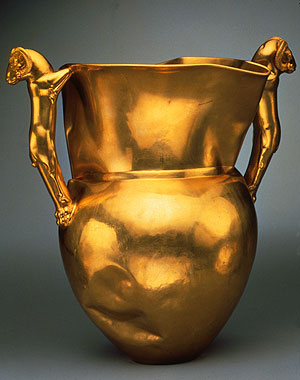
Amphora with mouflon-shaped handles, Achaemenid, 5th century B.C. Filippovka, kurgan 1, treasure pit 2. Gold; 9 x 7 1/8in. (23 x 1.8 cm).Archaeological Museum, Ufa.
This exhibition displays spectacular finds of gold and silver
recently excavated at
Filippovka in southern Russia-works that have never been seen
in the United States-along with related Scythian, Sarmatian, and
Siberian splendors from the State Hermitage Museum in St. Petersburg.
Created around the late 5th to 4th century B.C. by nomads living
in the southern Ural Mountain region of Russia, the distinctive
works from Filippovka include deerlike creatures of wood overlaid
with sheets of gold and silver, along with other striking objects
of precious metals.
The exhibition is accompanied by a catalogue.
The exhibition was organized by The Metropolitan Museum of Art,
New York, the
State Hermitage Museum, Saint Petersburg, Russian Federation,
and the Museum of
Archaeology and Ethnography, Center for Ethnological Studies,
Ufa Research Center
of the Russian Academy of Sciences, Bashkortostan, Russian Federation.
The exhibition catalogue is made possible by the Doris Duke Fund
for Publications. An
indemnity has been granted by the Federal Council on the Arts
and the Humanities.
More about This Exhibition
Between 1986 and 1990, hundreds of astonishing objects-ornately
carved and decorated in a unique style and covered in gold-were
excavated at an archaeological site outside the village of Filippovka,
located on southern Russia's open steppes. Representing one of
the most important caches of early nomadic Eurasian art, these
treasures date from the 5th to the 4th century B.C. and are characterized
by the extensive use of animal
imagery-most notably that of a deer. This fall, The Metropolitan
Museum of Art presents some 200 of these dazzling works-none of
which has ever been on public view anywhere-in a dramatic display,
"The Golden Deer of Eurasia: Scythian and Sarmatian Treasures
from the Russian Steppes," on view through February 4, 2001.
The State Hermitage Museum in Saint Petersburg (Russia) is lending
an additional 100 works-including many spectacular objects from
its fabled Gold Room-joining with the Archaeological Museum of
the city of Ufa (Bashkortostan) in this unprecedented international
exchange. Sixteen impressive wooden stags from the new find-some
almost two feet in height and covered with gold and silver-are
the centerpiece of the exhibition.
The exhibition was organized by The Metropolitan Museum of Art,
New York, the State Hermitage Museum, Saint Petersburg, Russian
Federation, and the Museum of Archaeology and Ethnography, Center
for Ethnological Studies, Ufa Research Center of the Russian Academy
of Sciences, Bashkortostan, Russian Federation.
An indemnity has been granted by the Federal Council on the Arts
and the Humanities.
The exhibition catalogue is made possible by the Doris Duke Fund
for Publications.
More about the Objects on View
Some two dozen kurgans (burial mounds) at the archaeological site
at
Filippovka were excavated over a period of four years in the late
1980s.
Although many of the kurgans had been partially plundered in antiquity,
exquisitely worked gold and silver artifacts in large numbers
were left
behind, indicating the burial of tribal chieftains. In addition
to several
dozen magnificent deer, almost two feet in height and with curving
antlers
rising above their richly patterned bodies, the excavation yielded
several
hundred elaborate gold appliqués, chased with figures of
animals both
natural and fantastic, which once adorned wooden bowls and drinking
cups. Many of these are on view in the exhibition at the Metropolitan.
Among the most significant works of art from the State Hermitage
Museum are the golden comb excavated in 1913 in the Solokha kurgan
(in the Dnepropetrovsk region, Russia) and the golden vessel discovered
in 1830 in the Kul' Oba kurgan (near Kerch, Crimea, Ukraine).
These magnificent Scythian works, both of which depict Eurasian
nomads, are beautifully modeled and show remarkable realism in
details of dress and anatomy.
The art of ancient Iran during the Achaemenid Empire (6th-4th
century B.C.) and its relationship to the finds from Filippovka
is illustrated by precious metal vessels from the Metropolitan
Museum's collection.
Stylistic affinities lie to the east, where there was a similar
use of spiral-shaped ornament on the surface of animal bodies.
Certain other characteristics, however, demonstrate cultural connections
with the Scythians, who occupied the shores of the Black Sea to
the west. The items excavated at Filippovka exhibit the same abundant
use of gold as the well-documented Scythian discoveries, although
the techniques used to create the objects differ greatly. Finally,
objects of foreign origin also unearthed in the tombs link the
people of Filippovka with other cultures. Among these remarkable
works are gold and silver items that resemble art from ancient
Iran. To suggest the complex relationship that appears to have
existed among these neighboring cultures in the first millennium
B.C., the presentation at the Metropolitan includes gold objects
from the Scythian tombs near the Black Sea; textiles, leather,
gold, and wooden works of art from Siberia; and gold and bronze
pieces from the Caucasus and Central Asia.
Scholars believe that the people whose stylistically unique
works were recently unearthed at Filippovka were a nomadic tribe
that occupied the area around the 4th century B.C. and were associated
with the Sarmatian people. The art found here resembles that of
other early Eurasian nomadic cultures-specifically in the multitude
and variety of animal forms used to adorn every manner of object.
Although the people whose works were discovered at Filippovka
favored the deer, various animals-including wolves, leopards,
birds of prey, boars, camels, elk, fish, rams, and griffins (a
mythological animal with the body of a lion and the head and wings
of an eagle)-were also found.
"The Filippovka find dazzles us by its beauty," commented
Philippe de Montebello, director of the Metropolitan. "But
these newly discovered works also compel us to delve more deeply
into their mysterious history. Who were the people who created
such astonishing masterpieces? While the question is debated,
we are delighted to provide the public with a rare glimpse of
the remarkable artifacts created by a little-known, yet highly
developed culture of long ago. We look to the ancient Greek and
Roman authors, who suggested that these people-neighbors of the
Scythians-may have been Sarmatians, as we display these enigmatic
treasures from Filippovka alongside those known to originate in
neighboring cultures."
Mr. de Montebello continued: "In drama and grandeur, 'The
Golden Deer of Eurasia' will recall another exhibition that also
featured the glorious art of the Scythians. The Museum's highly
acclaimed and immensely popular exhibition 'From the Lands of
the Scythians'-shown in 1975-was an early indicator of our ever-growing
fascination with the art of ancient civilizations."
 |
Amphora with mouflon-shaped handles, Achaemenid, 5th century B.C. Filippovka, kurgan 1, treasure pit 2. Gold; 9 x 7 1/8in. (23 x 1.8 cm).Archaeological Museum, Ufa. |
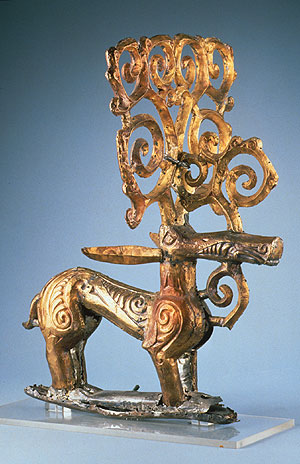 |
|
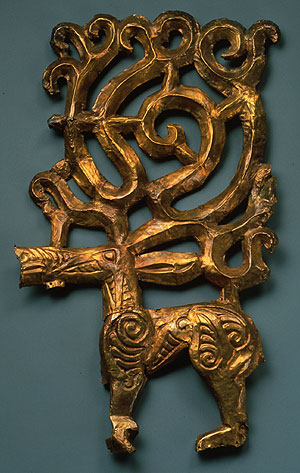 |
|
 |
|
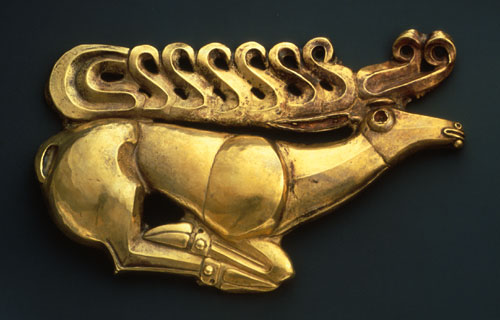 |
|
 |
|
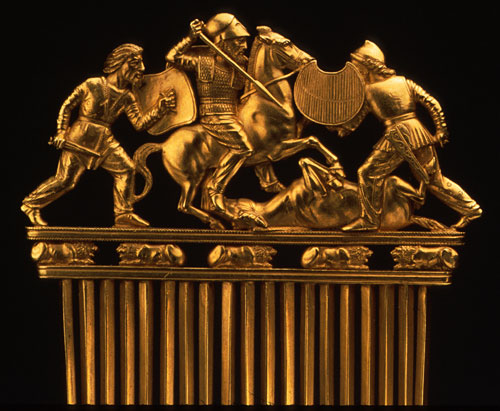 |
|
May I put unaltered images or text from the Metropolitan Museum's
Web site on a file server at my school or museum?
Yes, if there is no charge for the user and if electronic distribution
is of limited term to your school or museum only. The images must
remain unaltered. All of the accompanying caption information
must be included without alteration, and the citation should include
the URL "www.metmuseum.org."
May I put unaltered images or text from the Metropolitan Museum's
Web site on my personal Web site?
Yes, so long as the site takes in no advertisements and no sponsors,
does not charge a fee for services, and does not offer any product
or service for sale. The images must remain unaltered. All of
the accompanying caption information must be included without
alteration, and the citation should include the URL "www.metmuseum.org."
May I put images or text from the Metropolitan Museum's Web site
on a CD-ROM, public domain or otherwise?
No.
May I print selected images or text excerpts from the Metropolitan
Museum's Web site for a school report?
Yes, if it is a personal or academic work, and not for publication
in any medium. The images must remain unaltered. All of the accompanying
caption information must be included without alteration. You should
cite the source as you would any printed work; the citation should
include the URL "www.metmuseum.org." This type of use
is encouraged; all other forms of publication are expressly prohibited.
How do I obtain permission for other forms of publication?
Anyone wishing to use the Materials from this Site for purposes
other than as authorized herein must obtain prior written approval.
Permission for such use is granted on a case-by-case basis at
the sole discretion of the Museum. A usage fee may be charged
depending on the nature of the proposed use. For works of art
from the Metropolitan Museum's collection reproduced on this site,
in their entirety or as details, contact the Museum's Photograph
and Slide Library. For works of art from other museums or institutions
reproduced on this site, contact the institution credited in the
work's caption directly. For all other images on the site, and
for any text excerpts, contact the Museum's Web site by email:
web.site@metmuseum.org.